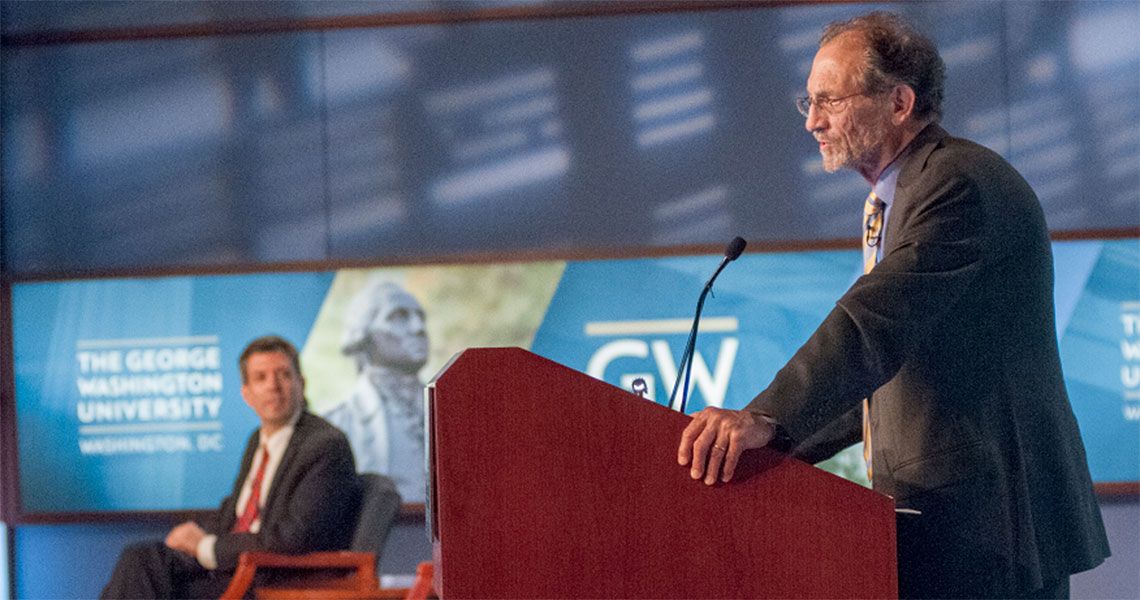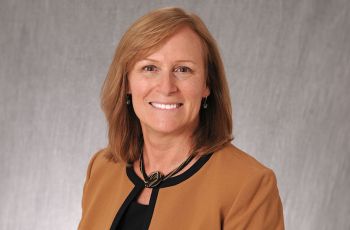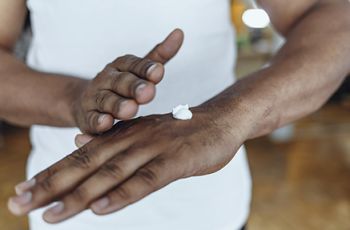The third installment of the Frontiers in Medicine Healthy Aging lecture series, designed to connect members of the Washington, D.C. metropolitan area with health care experts at the George Washington (GW) University, paired up dopamine and depression — pleasure and pain.
“This is a little different than just about every other Frontiers series we’ve had, bringing in two psychiatrists,” Alan Wasserman, M.D., the Eugene Meyer Professor of Medicine, and chair of the Department of Medicine at SMHS, joked at the start of the June 9 event. “It’s a little dangerous having two psychiatrists up on the stage, but we’ll give it a try and see what happens. This should be an incredible series.”
Focusing on the pleasurable side of brain behavior, Daniel Lieberman, M.D., professor of psychiatry and behavioral sciences at the GW School of Medicine and Health Sciences (SMHS), discussed what he called “the soul chemical.” Dopamine, he said, is a neurotransmitter, and in the brain, cells using dopamine are incredibly few: just 0.0005 percent. Despite the small number, “we spend the majority of our lives in the dopamine system,” he explained. That system, which includes the mesolimbic, mesocortical, and nigrostriatal pathways, focuses in one direction: up.
“Dopamine is the ‘up’ molecule, it’s the ‘future’ molecule,” Lieberman said. “Dopamine is responsible for maximizing the resources that we have access to in the future.”
As opposed to the here and now, and associated consummatory behaviors, dopamine incorporates space, time, and appetitive behaviors. Breaking down dopamine further, Lieberman explained that with the pathways come three essential elements: motivation (mesolimbic); abstraction (mesocortical); and action (nigrostriatal).
In looking at motivation, Lieberman pointed to the “reward prediction error.” “The purpose of the dopamine system is to maximize future rewards; therefore, only surprising rewards offer new opportunities for resource discovery,” Lieberman said. “We call this ‘reward prediction error.’ We discover the world is a better place than we thought it was.”
In other words, being surprised by something — a new bakery, a seat on the Metro, an excellent cup of coffee — results in a spike of dopamine, but only when the pleasure is unexpected.
The next step, abstraction, “is fundamental to adaptive behavior as it allows us to predict what will happen in situations we’ve never encountered” Lieberman said. “It’s the foundation of planning, in which a person searches a mental model of the environment to identify optimal actions.”
Once someone wants something — motivation — and can picture how to achieve it — abstraction — action is the final step. “We can think it, we can want it, we can have a plan, we’ve got to do it,” Lieberman said. “What the dopamine action system does is it basically gives orders.”
Between wanting, imagining, and doing, dopaminergic functioning can potentially answer one of life’s biggest questions, “What is the essence of who we are?” Lieberman offered free will, aspiration, creativity, and comprehension as the essence but noted that dopaminergic functions don’t account for love, sensory experience, and emotion, arguably also essential.
“It’s a great temptation to spend our lives in the phantom world of the future, the phantom world of what we want and how we’re going to get it,” Lieberman finished. “Yet once in a while, it’s probably a good idea to spend a little bit of time in the real world of the here and now.”
While dopamine may help answer the question of “who we are,” depression — the other half of the happiness/sadness pair — may seem amplified in the real world, particularly for those over age 60.
As James Griffith, M.D., chair of the Department of Psychiatry and Behavioral Sciences, the Leon M. Yochelson Professor and chair of the Department of Psychiatry and Behavioral Sciences at SMHS, explained, at that age, men and women have begun to experience more loss, whether it’s the loss of loved ones — parents, a spouse, friends — or of one’s career after retirement.
“Let me tell you the prototype of a patient called Mr. Smith,” Griffith illustrated. “He comes to see me. He’s in his late 60s, just retired, he’s been a leading figure in his organization for some time. He comes in and says, ‘I think I’m depressed.’ He tells me he lies awake at night remembering his working days. He has too much time alone. He’s apathetic with low energy.”
Griffith goes over the Hamilton depression scale, the most accurate assessment available, only to find that “his score’s only slightly elevated. He’s not going to be a candidate for anti-depression [medication]. So how do we understand that?”
In differentiating between depression and what Griffith terms “normal suffering,” the varying degrees of symptoms are key. Signs of depression include guilty ruminations; disturbed sleep, energy, appetite, and libido; and suicidal thoughts. “Probably the most reliable symptom for detecting depression is anhedonia: the inability to feel pleasure even if there’s something pleasurable to feel,” Griffith added. Treatments include electroconvulsive therapy (“gold therapy,” Griffith said) and transcranial magnetic, direct-current, and deep brain stimulations.
Signs of normal suffering or adversity, on the other hand, focus more on grief, demoralization, spiritual anguish, loneliness, and loss of dignity. Concentrating on loneliness, Griffith noted that “if there’s one fundamental fact about our American culture, I think it’s that most people underestimate the extent to which their sense of well-being depends upon the well-being of their relationships.” A possible solution then to normal suffering, which doesn’t necessarily require the medication of the more serious and harmful depression, is to avoid social isolation.
“Lonely people don’t take care of themselves,” said Griffith.
Taking a look back at Mr. Smith and his loneliness, Griffith said, “For the first time since his youth, he becomes involved in his local church; he gets involved in men’s groups and volunteerism. Soon, he’s not complaining of the same symptoms that brought him to me. This happened by renewal in the social world.”



